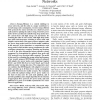Free Online Productivity Tools
i2Speak
i2Symbol
i2OCR
iTex2Img
iWeb2Print
iWeb2Shot
i2Type
iPdf2Split
iPdf2Merge
i2Bopomofo
i2Arabic
i2Style
i2Image
i2PDF
iLatex2Rtf
Sci2ools
TMC
2010
2010
Radio Sleep Mode Optimization in Wireless Sensor Networks
—Energy-efficiency is a central challenge in sensor networks, and the radio is a major contributor to overall energy node consumption. Current energy-efficient MAC protocols for sensor networks use a fixed low power radio mode for putting the radio to sleep. Fixed low power modes involve an inherent tradeoff: deep sleep modes have low current draw and high energy cost and latency for switching the radio to active mode, while light sleep modes have quick and inexpensive switching to active mode with a higher current draw. This paper proposes adaptive radio low power sleep modes based on current traffic conditions in the network. It first introduces a comprehensive node energy model, which includes energy components for radio switching, transmission, reception, listening, and sleeping, as well as the often disregarded micro-controller energy component for determining the optimal sleep mode and MAC protocol to use for given traffic scenarios. The model is then used for evaluating ...
Low Power | Low Power Mode | Sleep Mode | TMC 2010 |
Related Content
| Added | 31 Jan 2011 |
| Updated | 31 Jan 2011 |
| Type | Journal |
| Year | 2010 |
| Where | TMC |
| Authors | Raja Jurdak, Antonio G. Ruzzelli, Gregory M. P. O'Hare |
Comments (0)

